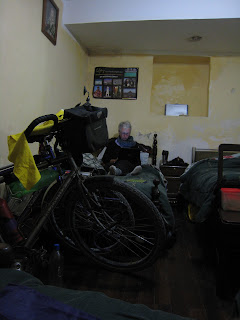 |
| Copacabana and Lake Titicaca |
Cycling slowly through an environment encourages a more minute investigation of detail. Slowly, I become aware of the freshly discarded ice lolly wrappers and their spatula sticks; both are fresh, unweathered, unbleached, untattered, and in numbers that count into the many hundreds. At first I speculated that it might be a shed consignment, only Poirot-reasoning states that the stick would be inside an unopened wrapper, stuck to the verge in a sticky blob. I filed the thought under ’unresolved issues’, and left the matter there. Just another of life’s great mysteries.
A days’ ride short of Copacabana and Lake Titicaca, we’re riding a switchback, the lago far below on both sides of our road that rises and falls as the mood of the land takes it. The route traversing one view, then fidgeting over, on to the other hillside. Looking down over an archaeology of ancient agricultural practice, pre-Hispanic terraces that range and rank from waterside to hilltop that speaks of centuries of hard toil and plant development. For it was off slopes like these that the two thousand varieties of potato emerged. From these terraces that a Scot’s national cuisine, a national condiment and a national challenge, emerged. Potatoes, tomatoes and chillies. Greasy chips, red ketchup and a drunken Vindaloo. Yet it’s along the roadside that a more modern development is happening, yet another personal mystery is slowly unfolding.
Groups of children, generally under the instruction of an older sister are ranged along the roadside, their spacing reflecting the relevant distance between their homes. Like the antisocial heron, they keep an impregnanable distance apart. Many have constructed shanties out of branches and plastic sheeting, or arranged elaborate constructs of stone, shelters that look semi permanent. Some play the beggar boy, doffing and offering their sun hats and calling for ’plata’, whilst others are asking for ’regalos’. Money or presents. There’s little malice, it’s more of a joke with some passing gringos. The boys with bikes set up a race, pacing us on the uphills, sprinting the downhills. They seem to be waiting for something better. At first I wondered if we had fallen upon an even greater level of poverty, yet the general countryside looked no different to what we’ve been moving through for the last few weeks, if anything, relatively more prosperous. These small gatherings have now stretched for over seventy kilometres, and still I’ve no answer. Another mystery.
Slowly more evidence is added; girls are playing with dolls, boys with small toy trucks. There’s packaging scattered down the concrete gully. All looks new.
Late in the day we cross the solution. A large white pick-up truck passes, then swerves into the verge, the passenger jumps out and starts distributing large paper bags from the back to the expectant kids. Santa’s come. The truck departs, and the chaperoning older sister takes charge, hides the goodies under the blanket, then they settle and await the next sleigh delivery. All this in the time it takes us to labour past, climbing up the next Andean hill.
A neat vignette, and for once a credible answer. Those ice lolly sticks? Same solution.




































